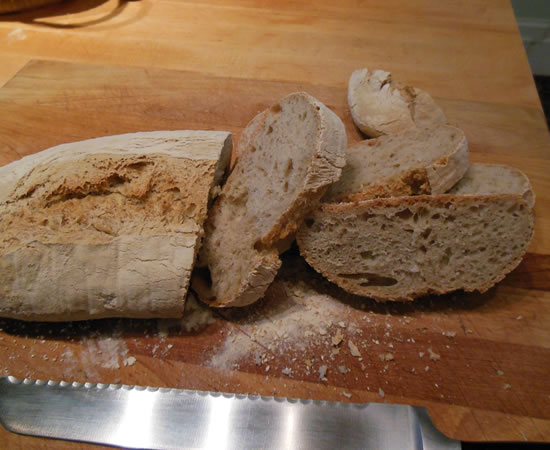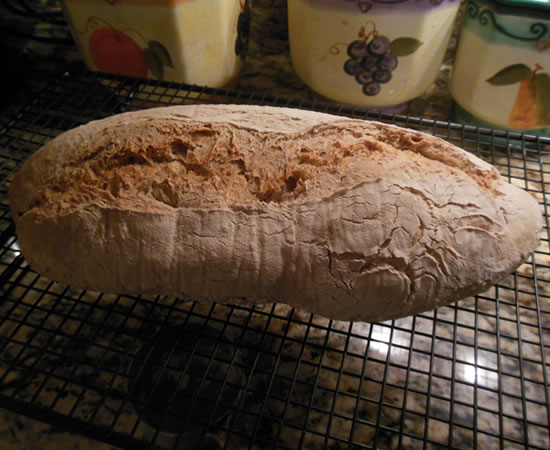Last week when I baked my Pane Pugliese, I split the biga into several baggies and froze it for later use. I pulled one out of the freezer last night ‘cuz I planned on making a loaf today. All seemed well… I chose Pane di Como Antico from Carol Field’s Italian Baker cook book and bright and early, started making the bread.
The house was a bit chilly and I wasn’t really concerned about the time it was taking to rise, since a slow, cool rise really makes for a more developed bread. But when it hadn’t budged after 4 hours, I knew there was a problem. Back into the mixer it went, along with a pinch of yeast, and into a warm room.
While I’m not sure what the end result is supposed to be, I ended up with a really good loaf of bread!
A nice chewy crust and a nicely-textured crumb made for a great accompaniment to dinner!
Sadly, I had to throw out the remaining biga in the freezer. But… I’ll make more! The biga needs to be made the day before you make the bread!
Another note is Carol Field specifies 1/4 cup of whole wheat flour but I like the flavor of rye flour, so I tend to use it when adding under a cup to a recipe.
Pane di Como Antico
adapted from The Italian Baker by Carol Field
Biga
- 1/4 tsp active dry yeast
- 1/4 cup warm water
- 1 1/4 cup water (room temperature)
- 3 3/4 cups unbleached all-purpose flour
Stir the yeast into the warm water and let stand until creamy – about 10 minutes. Stir in the remaining water and then the flour, one cup at a time.
Mix with the paddle attachment on the mixer at the lowest speed about 2 minutes.
Remove to a slightly oiled bowl, cover, and let rise at cool room temperature for 6 to 24 hours. The starter will triple in volume and still be wet and sticky when ready. Cover and refrigerate until ready to use.
Bread
- 3/4 c biga
- 3/4 cup water; At Room Temperature
- 1/4 cup rye flour
- 1 1/2 cups all-purpose flour
- 1 tsp salt
- Cornmeal
Mix the starter and water with the paddle in a large mixer bowl. Mix in the flours and salt. Switch to the dough hook and knead until softy and elastic, about 4 minutes. Finish kneading by hand on a lightly floured surface, sprinkling with additional flour, until smooth but still soft.
First Rise:
Place the dough in a lightly oiled bowl, cover with plastic wrap, and let rise until doubled, 1 1/2 to 2 hours. The dough is ready when it has numerous bubbles and blisters under the skin.
Shaping and Second Rise:
Divide the dough in half on a lightly floured surface without kneading it. Shape into a round loaf. Let it relax under a cloth for 20 minutes. Line baking sheet or peel with parchment paper and flour the paper generously. Roll ball into a fat cylinder and place seam side down on the paper. Dimple the loaf all over with your fingertips or knuckles, as for focaccia, to keep the dough from springing up. The dough should feel delicate but extremely springy.
Cover the loaf and let rise until doubled, with many visible air bubbles, 1 1/4 to 1 1/2 hours.
Baking:
Thirty minutes before baking, heat the oven with a baking stone in it to 425° . Sprinkle the baking stone with cornmeal. Very gently invert the dough onto the stone. Gently remove the parchment paper. Immediately reduce the heat to 400° and bake until golden, 35 to 40 minutes. Cool on wire rack.


